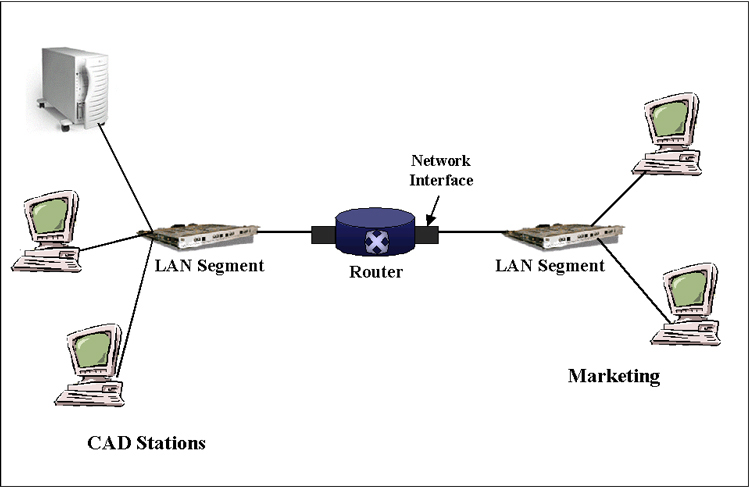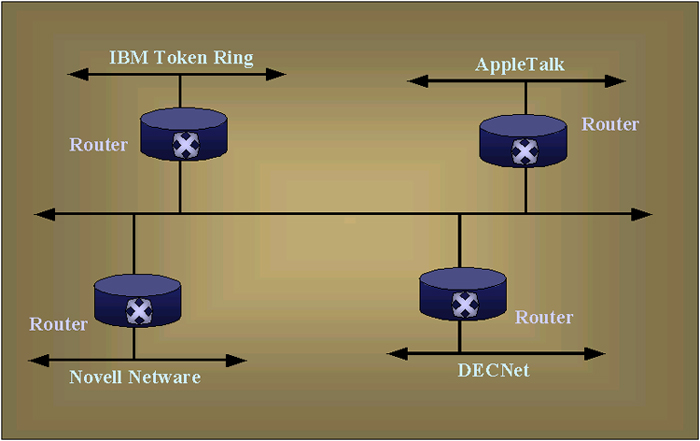
Routers
| Introduction.
A router is a device that forwards
traffic based on the IP address of the message. Routers have interfaces
to which LAN segments are attached to move packets of data between the
attached LAN segments. Routers are probably the single most
important devices in internetworking. They provide the flexibility
and programmed decisions that make it possible to get even incompatible
LAN segments to interact. Routers operate predominantly at layer 3
of the OSI Reference Model.
The following diagram represents these basic capabilities. |

| The above diagram could represent two different LAN
segments in the same engineering firm. The segment on the left is
used by engineers engaged in computer aided design, which is very highly
resource intensive. The segment on the right is used by
marketing. To keep the CAD engineers from bogging down everyone's
use of the network, they have been put on their own segment. The
router essentially protects everyone else's use of the network from
their CAD engineers demands, yet allows interaction when it is
desired. For example, maybe marketing needs to start developing
the ads for a new design.
One of the other major aspects of routers is illustrated in the following diagram. |

| Here we have LAN segments that all using different
operating systems and even some different network types. A routers
ability to be configured to support different protocols simultaneously
is probably its most important feature. This is largely done
through what are called interface modules.
These modules are actually physical printed circuit boards that handle
particular networking protocols.
The following list displays the most important router capabilities.
Now I want to present some of the basic CISCO line of routers. I will also present some routers made by their largest competitors. |
CISCO Routers
| SOHO Routers.
SOHO is an acronym for small
office/home office. It is usually the case that SOHO
users have only one or two LAN segments and an ISP connection to the
internet. SOHO routers emphasize dial-in technologies, usually DSL
or ISDN.
The following table outlines CISCO product offerings. Remember the term series means a chassis that is variously configured at the plant into different product models usually most determined by their particular printed circuits cards. |
| SOHO Routers | |
| Product Series |
Description |
| Cisco 77 | DSL access router to connect multiple users. Includes user configurable IOS. |
| Cisco 600 Series | DSL access router for a single. Doesn't have user configurable IOS. |
| Cisco 700 Series | ISDN access routers to connect up to 30 users. Doesn't have user configurable IOS. |
| Cisco 800 Series | ISDN, DSL and serial access routers to connect up to 20 users. Includes IOS and has VPN encryption capability. |
| Cisco uBR900 Series | Integrated VoIP, VPN, and router functionality for telecommuters and small offices. Includes user configurable IOS. |
| Midrange Routers.
Small to medium sized networks require a wide variety of solution
approaches largely based on capacity needs and type of telecom link. The following table outlines CISCO product offerings. Various combinations of LAN technologies and WAN media can be configured. Modular means that the chassis can be upgraded on-site by inserting one or more modules. Non-modular devices are fixed in configuration when assembled. |
| Midrange Routers | |
| Product Series |
Description |
| Cisco 1000 Series | Ethernet access router to connect to either an ISDN or a serial WAN link. |
| Cisco 1400 Router | Ethernet access router to connect to either an ATM or a DSL trunk. |
| Cisco 1600 Series | Ethernet access router to connect to either an ISDN or a serial WAN link. Includes VPN encryption ability. |
| Cisco 1700 Series | Ethernet access router to connect to a broadband, ISDN, or DSL WAN link. Includes VPN encryption ability. Also includes VoIP and VoFR capability. |
| Cisco 2500 Series | Ethernet or Token Ring router/hub or dial access server models to connect one or two LAN segments to an ISDN or serial link. |
| Cisco 2600 Series | Modular and cost-effective solution for duty as access router, voice/data gateway, or dial access server. Connects one or two Ethernet or Token Ring LANs to ISDN, channelized T1, Ethernet, analog modems or ATM links. Also supports voice/fax and Frame Relay. |
| Cisco 3600 Series | Modular high-density router for dial access or router-to-router traffic. Supports ISDN, serial, channelized T1, digital modems and ATM links. Also supports voice/fax and Frame Relay. |
| Backbone Routers.
These models allow CISCO to make the claim that over 70% of the Internet
is run using its routers. The bigger routers actually resemble
dorm refrigerators and have data buses which accept blades
- whole devices on boards. Because they aren't access
routers they can handle as many users as they can handle packets.
All of these products are modular and can operate more than one protocol
simultaneously. A slot is an
electronic bay into which a printed circuit board can be installed. The following table outlines CISCO backbone product offerings. |
| Backbone Routers | |
| Product Series |
Description |
| Cisco 4000 Series | Three slot routers supporting Ethernet, Fast Ethernet, Token Ring, FDDI, HSSI, serial, channelized T1 and ATM. |
| Cisco 6400 Router | DSL Router for ISPs and corporations. Supports Ethernet, Fast Ethernet, Gigabit Ethernet, Token Ring, DSL, broadband and ATM. |
| Cisco 7000 Series | Four to thirteen slot central site routers supporting Ethernet, Fast Ethernet, Token Ring, FDDI, HSSI, serial, ISDN, channelized T1, packet over DS3 and ATM. |
| Cisco 10000 Series | Ten slot Gigabit Ethernet switch router. Has special card for OC-12 WAN link. Offers IPSec, MPLS VPN and QoS (Quality of Service) capabilities. |
| Cisco 12000 Series | Eight or twelve slot Gigabit Ethernet switch router optimized for IP. Has special cards for OC-12 and OC-48 WAN links. |
| Cisco uBR7200 Series | Two to four slot broadband, carrier class routers. It's designed for cable operators and service providers. This series connects residential subscribers for high speed data, broadband and IP telephony. |
| Cisco uBR10012 Series | Broadband, carrier class routers. It's designed for cable operators and service providers. This series connects residential subscribers for high speed data, broadband and IP telephony. |
| This information will be updated intermittently. In addition, I will post some offerings from CISCO competitors while trying to focus on those with largest market share. Any assistance in this will be greatly appreciated. |